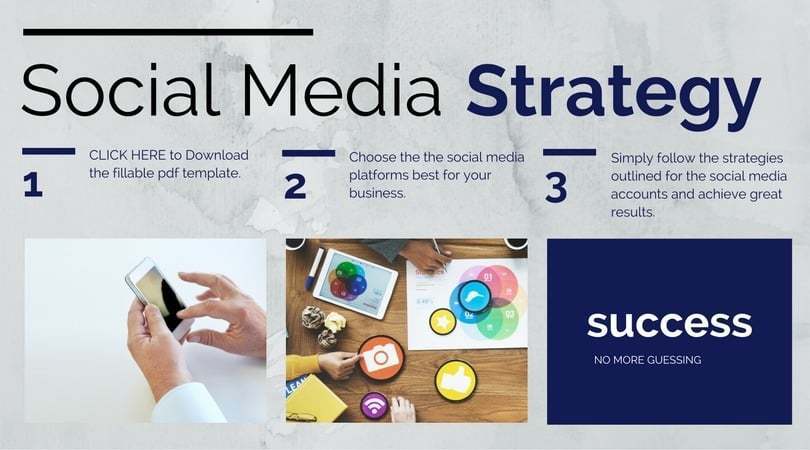Social media is absolutely essential for businesses in 2016. But starting out on social media is certainly not easy. In fact, unless  you come at with a strategy in mind, your efforts will very likely fail. However, with a proper social media strategy in place, you can take control of your web presence, increase your visibility to customers and even make more sales. Let’s take a look at how you can get started with a social media strategy in 6 easy steps.
you come at with a strategy in mind, your efforts will very likely fail. However, with a proper social media strategy in place, you can take control of your web presence, increase your visibility to customers and even make more sales. Let’s take a look at how you can get started with a social media strategy in 6 easy steps.
1. Think About Your Goals
Before you go creating profiles on every social media page, sit down and ask yourself, what are your business goals? How can you use social media to accomplish them? Sit down for a moment and figure out what you actually want to do with social media — not just what you have to do. Do you want to get people to your website, or just start up a conversation on Facebook? Are you more concerned about finding new clients right away, or are you thinking of building long-term value for your brand? Do you want to provide support for your customers or share promotions to drive more sales?
Write down what you want to do. At this point, you don’t need to have hard numbers. Just have a basic outline of what you want to accomplish.
2. Figure Out the Best Platform(s)
Once you know what you want to do, it’s time to look at which social networks are the best option to get you there. Don’t fall into the trap of thinking you have to be on EVERY social network. In fact, that’s a good way to stretch yourself too thin. Concentrate on the ones that will be of the greatest value, where you know most of your audience is hanging out already.
But what if you don’t know where your audience is hanging out? What if you don’t know much about your audience to begin with? Now is an excellent time to start figuring that out. Look at your business data. Think back to your interactions with customers. Some data to consider:
- Demographics: Age, gender, geography. Don’t forget to consider income level or profession.
- Life cycle: Is your audience single or married? Do they have kids?
- Psychographics: What is your audience or customer base concerned about? What is important to them? What values shape their lives?
Once you understand what your customers are like, how they live their lives, and what they are interested in, you can start to figure out where they might spend their time online.
Not only that, but you can also use social media platforms to research and find your audience online. On Facebook, for example, you can see exactly how many people fit your target profile (such as the number of women in Chicago who are interested in entrepreneurship). This is a great way to tell whether there’s a viable market for you, or whether you need to re-think your products, services, or target market.
Every social network has its own unique flavor and demographics. What’s right for you might be the worst choice for someone else. But here’s a run-down of the major networks to consider:
1. Facebook
The largest social network also has the broadest base. It is very much a catch-all type of network, where you can connect with consumers as well as other businesses. Maintaining your Facebook page is often less of an investment than some other networks because you aren’t expected to post quite as often as you would on say, Twitter. Facebook lets you share text, images, and videos, and it has a powerful advertising platform.
Resources for Marketing on Facebook:
Entrepreneur: Dominate Facebook With This $5 Marketing Strategy
Social Media Examiner: 9 Facebook Marketing Strategies to Build Super Fans
2. Twitter
Twitter sets itself apart from many other platforms in that its messages are limited to just 140 characters, and it shows posts in real time. Twitter has a smaller following than Facebook, but it’s popular for businesses because many journalists, bloggers, entrepreneurs, and thought-leaders use this platform. It is a popular medium for customer service, for sharing blogs and other content, and for connecting with influential people, which means it’s especially useful if you’re in the B2B space.
Resources for Marketing on Twitter:
Social Media Examiner: Twitter for Business
Twitter for Business Basics
3. Instagram
Owned by Facebook and designed for sharing photographs, Instagram is far more than selfie-central. It is hugely popular with millennials and younger audiences. While you can view photos and feeds in a web browser, Instagram is really more of a mobile tool. If your business is particularly photogenic (restaurants and retailers, for example), this is a great option. Even better, it allows you to cross-post to Facebook and Twitter.
Resources for Marketing on Instagram:
SproutSocial: 15 Instagram Marketing Tips for Engagement
Social Media Examiner: 13 Instagram Marketing Tips from the Experts
4. Pinterest
A digital bulletin board famous for its popularity among women, Pinterest supports and embraces content covering a huge number of topics. Recipes and craft projects are only a small part of the Pinterest eco-sphere. Look deeper and you’ll find all sorts of helpful how-to’s covering entrepreneurship to parenting. It’s also the most popular social media platform for shopping. If you have a retail business, or you blog regularly, Pinterest might be a good investment for you.
Resources for Marketing on Pinterest:
Pinterest Marketing Tips from Buffer
Social Media Examiner: Pinterest Marketing Tips
5. LinkedIn
Conceived as the social network for career-minded professionals, LinkedIn remains a great platform for connecting with industry leaders and finding potential leads. It’s a great platform for B2B marketers and professionals who really want to define their brand. You can share content easily, making it great to position yourself as a thought-leader.
Resources for Marketing on LinkedIn:
LinkedIn Small Business Marketing Guide
Social Media Examiner: 6 Powerful LinkedIn Marketing Tips for Small Businesses
6. Google+
Google+ might have started its life as just an alternative to Facebook, but it has finally come into its own as a solid platform for curating and sharing content as well as connecting with like-minded communities. It is still by no means as popular as any other social network, but if you find a particularly engaged community in your industry, it could be worthwhile for you.
Resources for Marketing on Google+:
Social Media Examiner: How to Use Google+ Collections for Business
AdEspresso: 6 ways to Spruce Up Your Google+ Marketing Strategy
There are plenty of other social platforms — Tumblr, SnapChat, Kik, Yik-Yak, Vine and Periscope, to name a few. However, the ones we’ve covered still make up the core of digital marketing and are likely your most lucrative options.
You can also check out this WishPond post about the best social media platforms for your needs, or Hootsuite’s guide to the best social media sites for marketers. For more data about where the various social networks stand in comparison to each other, checkout this SmartInsights post.
Whichever networks you pursue, you should limit yourself to no more than 3. It can be tempting to go overboard, but you’ll just be spreading your resources around and not getting much traction with any of them.
3. Start Strategizing
At this point you should have a pretty solid idea of your potential customers and audience for social media — and where you want to concentrate your efforts. Now you take those general concepts of what you want to achieve, and transform them into specific, actionable goals. Write a mission statement if it will help you focus. Draft some specific guidelines to follow regarding your tone of voice and what kind of content you’ll share. Create a timeline and set some specific milestones and targets.
Create a document that you’ll refer to as time wears on and you want to check your progress. If you need some help creating this document, check out Hootsuite’s selection of templates. You can also check out Duct Tape Marketing’s guide to a social media plan for more advice on your strategy,
Be realistic in setting your goals and milestones. You’re not likely to achieve 100,000 followers in a year. But 1,000 in a year? Absolutely possible. 1,000 in 6 months? Also possible, though you’ll have to work a bit harder.
4. Build Your Profiles
Building a social media profile isn’t all that complicated, but there are a few subtle ways you can optimize each profile to increase the likelihood someone will follow you or take another action you want them to take.
First things, you’ll want to make sure you choose images that work best with the dimensions on each network. HubSpot has a great guide to the appropriate dimensions here.
Then it’s time to work on your bios. Each network gives you different amounts of space, but you should try to standardize your message across each platform (within reason). Let people know who you are, who your company is, and what you’ll give them.
Hootsuite, a social media management platform, has a great guide on how to set up social profiles on each of the major networks. You can also check out Sprout Social’s guide to Twitter bios.
5. Start Accumulating Followers
Once you’re on your chosen social media networks, it’s time to start acquiring some followers!
There are a LOT of ways to do this. Some are legitimate. Some are less so. Right off the bat, you need to know that follower count is only one small part of a successful social media presence.
That’s because the internet is full of fake social media profiles. Sure, you can pay someone to get you 500 followers overnight, but if they’re phony accounts, they’re not going to engage with your content, they’re not going to share your content, and they’re not going to tell others about your business.
So don’t feel tempted to go buy followers. On Facebook in particular this can be outright disastrous, because its algorithm, which determines who gets to see your posts, is determined in part by how much engagement it gets relative to your follower base.
Instead, focus on legitimate ways of getting followers. Some of those options include:
1.Ask your friends and family to like or follow your social media profiles. Ask them to ask their friends and family. Just be careful not to spam them with requests or be overly aggressive about getting them to follow your profiles.
- If you have a website, add social media buttons to your website to let your current web visitors know you’re also on social media. WordPress has a simple widget you can add to your website to advertise your profiles.
- Add social links in your email marketing newsletters. Include them in the header or footer of the email so people know that they can find your profiles and follow you.
- Consider advertisements. If you have a little bit of money to spend, you can run advertisements on both Facebook and Twitter to get more fans. Remember to target your ads based on your customer base or your ideal customer profile. If you offer business consulting services you might consider targeting people who follow Forbes of Entrepreneur magazine, for example. However, it’s best to fill out your profile first and get some content going so people know that your profile is active and offers value.
A final friendly reminder: Don’t spam. You don’t like the junk mail that arrives in your inbox, right? No one likes to be spammed. There’s an admittedly fine line between self-promotion and spam, but err on the side of caution here.

6. Find and Create Content
There is no sense in having a social media account if you are not going to use it. That means you need to post content. Content can be anything — the only rule is that it needs to be useful or informative or entertaining in some way. Some options include:
- Videos
- Pictures
- Infographics
- Blog posts
- News articles
- Surveys and Polls
What kind of content you post is going to tie back into what your business goals are, what your social media goals are, who your followers are and what they’re interested in. But, for example, a restaurant owner might post a picture of a daily special from the menu. A consultant might post a link to a blog post about useful tools for businesses. A graphic designer might share an infographic about the basics of color theory.
You can (and should!) create your own content, but you can also curate content from other sources. This is where in your social media strategy you should sit down and identify influencers — people that others in the industry look up to, authorities whose opinions the public trusts. Start following them on Twitter. Check out their blogs. Share posts from their Facebook page. This reduces the effort you spend on creating content while still providing value for your audience.
You should look for a mix of promotional, entertaining, and informative content. The right balance depends on the business and the industry. However, it’s generally a good practice to focus on information and entertainment and keep promotional posts to a minimum. Remember, no one likes a spammer. Be sincere. Ask questions, show interest in what others have to say.
7. Invest in the Right Tools
As a business owner (and sometimes as the sole employee), you don’t want to spend all your time chained to your computer making Facebook posts or tweeting at your followers. It’s time-consuming and inefficient.
You can find a massive array of social media tools online. They typically serve up to four purposes:
- Allowing you to schedule social media posts for a variety of networks from a single platform.
- Allowing you to see how effective your social media posts are (analytics and reports).
- Finding and sharing content.
- Engaging with others on social media.
There are a few advantages of this: For one, you can schedule posts in advance, and schedule multiple posts across each network. Two, you can get advanced data on what’s working best for your social media efforts. Many of these tools even offer a mobile option so that you can make posts from your smartphone or respond to a question or tweet from a customer.
While most social media tools serve the same functions, each one is unique. Some have unique features; others have a free option if you’re just starting out. You should investigate the options and choose the one that works best for you. Some of those tools include:
- Hootsuite
- Sendible
- Buffer
- Sprout Social
A final reminder: Don’t forget to take advantage of the analytics tools! You should be looking for signs of what is working in your strategy and what isn’t. Keep doing what works, and cut out what doesn’t. Compare your success against your documented strategy to make sure that you are on track to accomplish your goals and build a thriving social media presence!
Are You Ready to Take the Next Steps?
You’ll be much better prepared for growing your social media presence — and your business — if you approach it with an organized plan in hand. This requires knowing your brand and your customers. Doing some research into the demographics of each social network and how other businesses are using those channels will give you an idea of what you can do with your own profiles. Choose realistic goals with solid numbers and time frames — then figure out how you’re going to achieve those goals. When you’ve done that, you’re well on your way to becoming a social media expert!
Social Media Fillable PDF Strategy Template
This guide will walk you through each of the social platforms. Sharing how to create results by providing the direction to take your strategy and the tasks to perform.
This is the guide I use to establish client’s strategy and help their businesses grow and gain profits!
Click here to access the Social Media Guide
